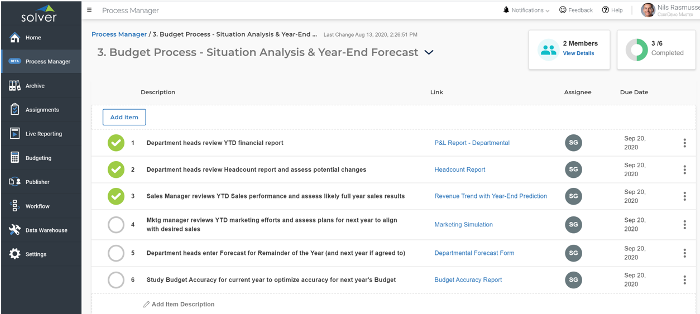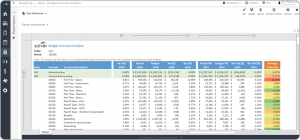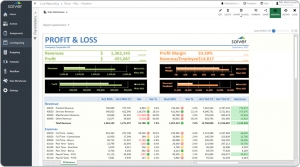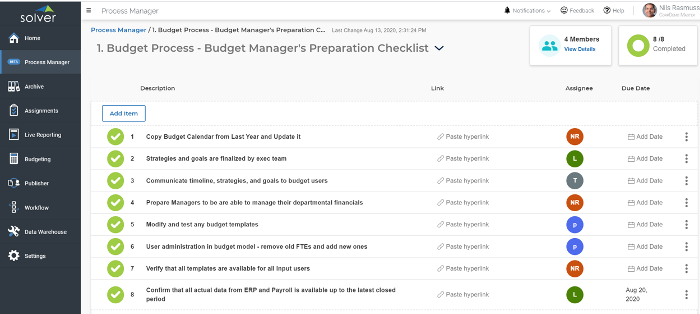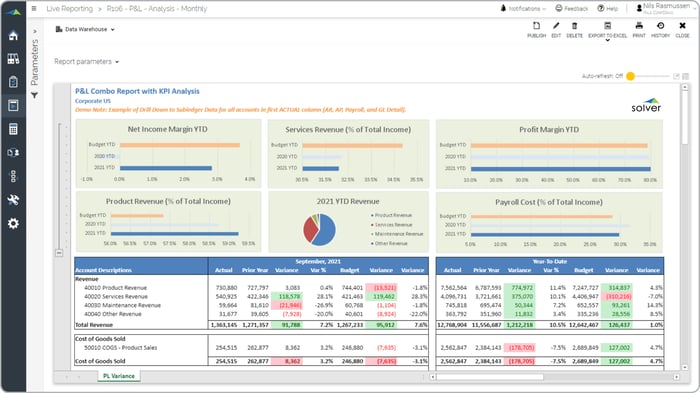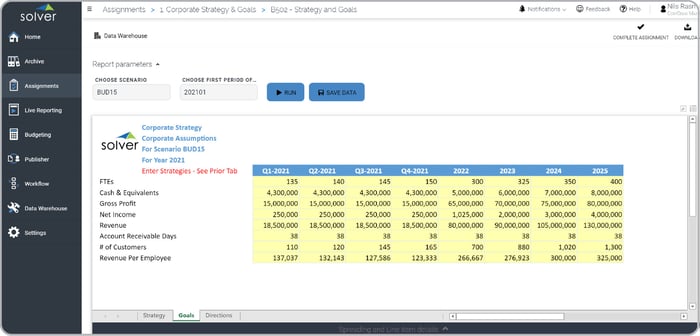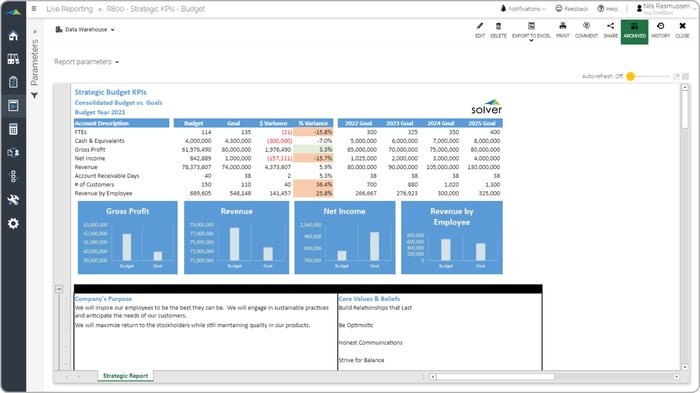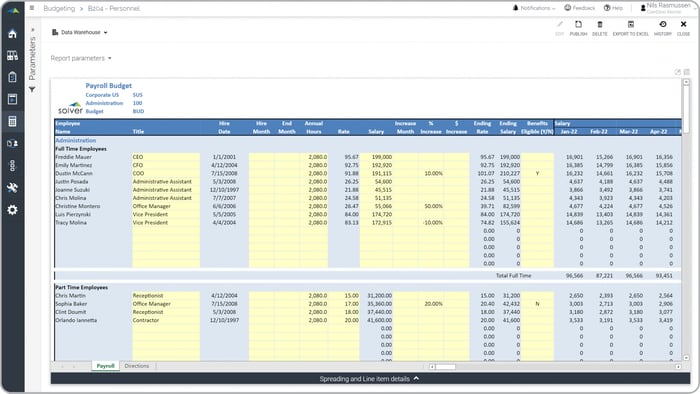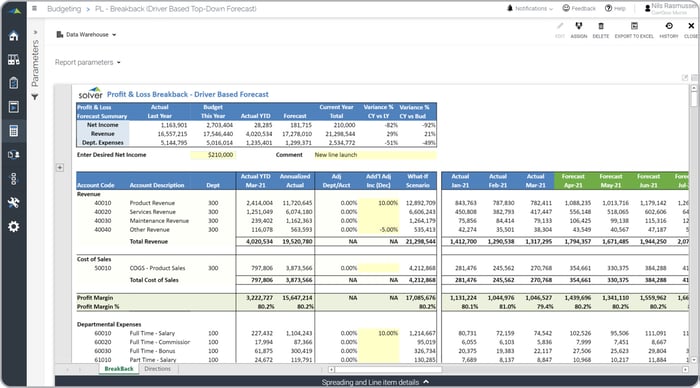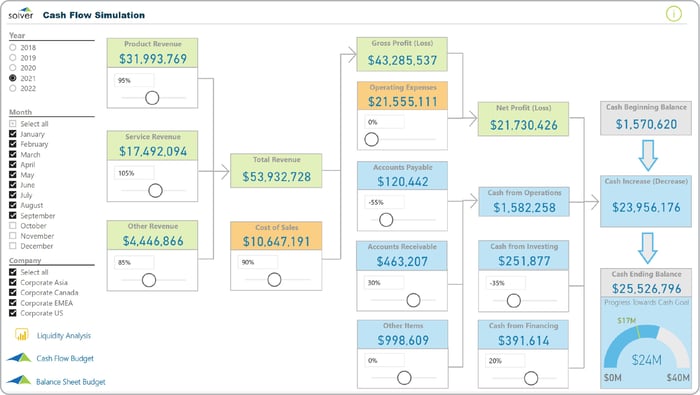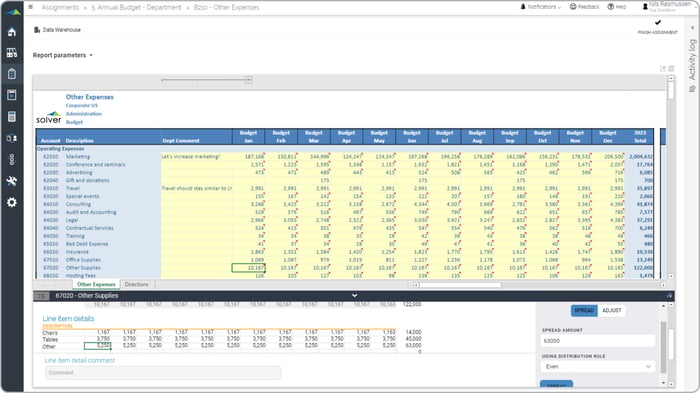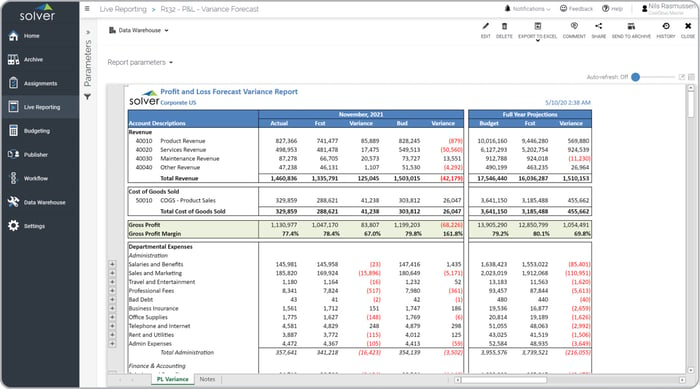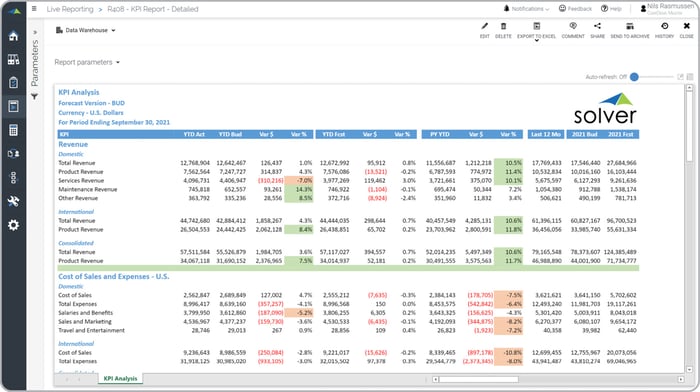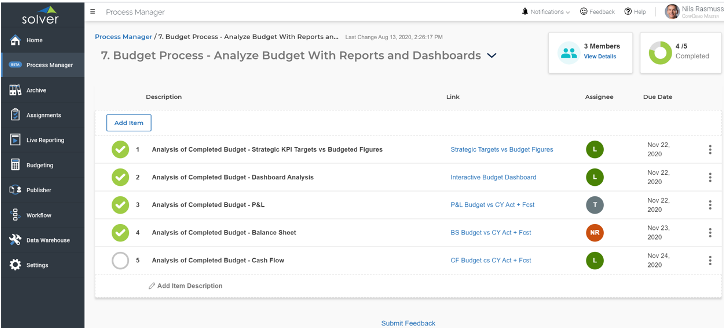Related Posts
- How the Solver Contributor User Expands Budget Planning Beyond Finance
- Advanced Planning Tools Foster Business Success
- Do Better Than a Business Budget Excel Template
- Strategic KPI Report for Dynamics 365 Business Central
- Monthly Balance Sheet with Prior Month and Last Year Comparisons for Dynamics 365 Business Central
9 Budgeting Process Best Practices

The economic uncertainty of the last few years has demonstrated that financial leaders across the globe must be able to operate with greater agility. But many finance leaders are still struggling to gain insight into their business futures.
Outdated processes, time-consuming input methods, and overly complex Standard Operating Procedures (SOPs) are just some of the many issues resulting in unclear decision-making and a feeling that all future financial plans are simply “guesswork.” Added together, these issues are likely to result in unsuccessful and unrealistic Annual Budgets.
Savvy financial leaders understand that today’s rapidly and drastically changed business landscape requires rapid and drastic changes to the budgeting process in response… but it can be difficult to determine what the best steps are when the future is so uncertain.
If you are ready to transform your Annual Budgeting process to a more agile, more responsive, and more streamlined set of procedures that you can leverage for greater planning confidence, check out these budgeting best practices compiled by experts.
Read the full article or jump to a specific section:
- What You Will Learn in This Document
- Understand the Power of Strong Process Management
- Find Out Now: Is Your Annual Budget Process Broken?
- 9 Budgeting Process Best Practices
- 1. Begin Your Preparation Checklist
- 2. Complete Year-to-Date (YTD) Analysis and Forecasting
- 3. Set Your Strategic Goals
- 4. Select Your Best Budget Input Process
- 5. Plan Carefully in Times of Uncertainty
- 6. Enjoy 4 Key Outputs of a Successful Annual Budget
- 7. Treat Your Annual Budget Like a Project
- 8. Always Challenge the Numbers
- 9. Invite Executive and Board Feedback Early On
- Get Started Today with a Sample Budget Process Flow Calendar
- Now Is the Time to Start Your Annual Budget Process
What You Will Learn in This Document
After reading this document on budgeting process best practices, you will be prepared to handle uncertain economic futures with greater levels of confidence. You will know what steps to take, and in which order, to set the stage for a successful Annual Budget process – and you will have a good handle on the various approaches you can take for budgeting at your company.
This document is detailed and lengthy, meant to guide you every step of the way through this year’s Annual Budget process and beyond. You may prefer to print out the full document or save it directly to your tablet, so you can use it as a reliable reference piece for the next few months and years.
Ready to get started? Let us begin by talking about why having a strong process matters for your Annual Budget activities and what may be “broken” in your current process.
Understand the Power of Strong Process Management
Processes are powerful. In fact, effective processes often form the essential difference that gives many of today’s leading companies their competitive advantage. When implemented properly, a strong process will lead to strong action and strong results.
Most companies can strengthen their Annual Budget process. Doing so leads to numerous benefits, including:
- Faster, more informed decisions
- Improved accountability
- Significant resource and time savings
- Revenue and profit acceleration
Do those benefits sound like a fantasy? They are actually relatively easy to achieve – as long as you and your team are ready to put in the work focusing on budgeting process best practices that help you develop strong processes.
Best practices recommend that you have:
- Well-defined Corporate Performance Management processes
- Clearly stated process owners
- Precise due dates for tasks and/or processes
- Transparency – meaning that processes are easy to access and view by stakeholders
- Full accountability
This document will explain how you can set up a strong Annual Budget process for your company – but let us first look at the obstacles you may come up against while trying to set up your own processes.
Find Out Now: Is Your Annual Budget Process Broken?
No matter where your company is located globally, your finance department shares at least one commonality with every other finance department in the world: you are extremely busy.
Due to a massive workload, constantly looming month-end-close deadlines, and a staggering number of manual processes, finance departments often delay process and procedure reviews or updates. This means you may be maintaining cumbersome, outdated standard operating procedures for far longer than necessary.
Traditional financial planning processes rely on analyzing historical records and trends, entering data manually into Excel, and running quarterly reports on what already happened to see what might come in the future. These processes are slow and, to be frank, today’s finance departments do not have the time or economic certainty to place much trust in sluggish processes.
Working in today’s rapidly shifting economic environment, slow processes are likely to “break” your budgeting process.
Is Your Budgeting Process Flow “Broken?”
Find out if your budgeting process is broken when you check to see how many of the following warning signs your process exhibits:
- You are using Excel almost exclusively
- You do not have a central database for Annual Budget data
- You run into broken links too often for comfort
- You have limited security due to the ability to freely share Excel files
- You have multiple versions of the same Annual Budget and have troubles determining which one is the final one
- Your users and stakeholders miss deadlines (lack of accountability)
- Your process delivers limited, if any, guidance on goals and strategies that impact the annual plan
- Your input process does not allow supporting details to be entered for context
- You experience a lack of communication between departments, leading to siloed planning in a synced-up world
- You suspect that some department leaders may be focusing on their own interests and participating in gamesmanship or sandbagging
Did any of these warning signs sound familiar? By using a Corporate Performance Management solution like Solver, you can easily fix these problems with:
- A cloud and web browser-based platform that encourages full collaboration
- Line item detail and comments for context and other information
- Capture and display strategy and KPIs for clear guidance
- Process management and workflow tools
- Protected web forms for solid data security
- Automation for scenarios and more
- Top-down/bottom-up planning flexibility
9 Budgeting Process Best Practices
The key to solving issues and fixing your “broken” Annual Budget process is to be prepared to accomplish more agile, streamlined, and modern budgeting. Best practices suggest that you begin your preparations with clear steps, to be completed in precise order.
In the next sections, you will learn the budgeting setting process step by step.
1. Begin Your Preparation Checklist
Success is much more likely if you have prepared for a successful outcome. When you feel you are ready to transform your budgeting process to achieve success in times of economic uncertainty, simply return to this section and write down each step in this Preparation Checklist.
Pave the way to success for your Annual Budget by following these steps:
- Finalize and communicate your strategies, goals, timelines, and targets
- Create a “project plan” for your Annual Budget
- Complete an end-of-the-year forecast (see the next section for details)
- Empower managers with the ability to manage their own department financials
- Modify and test any templates, and make sure they are available to all team members who need them
- Add any new users and verify their security settings
- Confirm all data is appropriately accessible
- Start early – we all know that the early bird gets the worm!
You can do all this manually of course, but it is much easier and faster to complete these steps using a purpose-driven tool like the Solver Process Manager.
The Solver Process Manager makes it easy to create checklists, assign tasks to various personnel, and enjoy full transparency and access to secured, cloud-based checklists that are readily available to authorized users.
2. Complete Year-to-Date (YTD) Analysis and Forecasting
To know where you are going, you must start by knowing where you are. In a time of economic uncertainty, this is easier said than done – but it is certainly not impossible.
When you take a deep look at your current performance, you can then gain a reasonably accurate initial glimpse into your future by forecasting potential scenarios and performing fundamental analysis.
Not sure where to start with this process? Here are some tips drawn from best practices recommendations:
Look at Your Current Performance
- Have department managers review their financials
- Understand current and future headcount needs
- Determine Sales team productivity
- Dive into marketing effectiveness
Run a Realistic Forecast
- Perform a 7+5 forecast in August (with 7 actual + 5 predicted months)
- Set corporate strategies and goals for next year (see the next section for details)
- Forecast through next year to provide vision and insight
- Check your forecast accuracy and identify any potentially overlooked areas
Perform a Fundamental Analysis
- Start your analysis now to ensure that you are ready for your Annual Budget process in time
- Review assumptions and the accuracy of your prior year’s budget
- Review all contracts, especially ones for recurring revenue
- Assess how current and future strategies may impact your new hires and promotions
When you are ready to begin your YTD Analysis and Forecasting, a Corporate Performance Management solution like Solver can assist by delivering a range of easy-to-use templates and reports, including:
- Profit & Loss Variance Report
- Headcount Report
- Sales Simulation Dashboard (interactive – try it yourself!)
- Sales Dashboard
- Campaign KPI Report
- Budget Accuracy Report
- Driver-Based Sales Forecast Form
- Liquidity Risk Report with Forecast
- Driver-Based Payroll Forecast Form
- Department Forecast Form
3. Set Your Strategic Goals
One of the most important budgeting process best practices tasks lies in setting strategic goals for the next year. This is a task largely for Executives and Board members, who must set goals based on strategies and initiatives and take various factors into account.
When setting strategic goals, Executives and Board members should make sure to carefully consider:
- Revenue growth
- Cash flow
- Profitability
- Investments
- Unique critical financial areas
Once strategic goals have been set, they must all be clearly communicated to the management team and special care should be taken to ensure that all managers are on board. All feedback should be taken in by the Board and Executive team, with a willingness to modify the goals as needed.
After goals are agreed to, the Executive team should work with the management team to set specific departmental goals based on corporate targets. Both groups are likely to gain more from this exercise if they concentrate on the “how” when determining initiatives, instead of simply focusing on the “what,” as they may have done in prior Annual Budgeting cycles.
Note: Budgeting process best practices recommend that Annual Budget planning should NOT start until this last step is finalized and agreed to.
It can be difficult to set executable strategic goals in times of deep economic uncertainty, but a Corporate Performance Management solution like Solver can help by providing various reports and forms that help you capture multiple scenarios (e.g. “High,” “Low,” “Mid”) and communicate your strategy and goals clearly and concisely.
When assessing a Corporate Performance Management (CPM) solution for your strategic goal-setting process, ensure that the tool you choose includes, at the very least:
4. Select Your Best Budget Input Process
Once all prior steps and preparation tasks are complete, it will be time for you to officially begin your Annual Budget process.
You have two ways you can approach your budgeting process: top-down or bottom-up. It is important to note that neither of these approaches is “better” than the other – they each simply address different ways of looking at the same budget planning puzzle.
In best practices organizations, both methods are used:
- First, the office of finance creates the top-down budget and disseminates it to department managers as a “baseline” budget.
- Then each department makes a bottom-up budget, either by revising the top-down budget or as a new budget version in the system. The latter is recommended, as managers can then later compare the two versions and see where there are differences.
Top Down
The “top-down” budget process focuses on modeling expected outcomes at the senior management level and working down to the details from there. Top-down forms a more “high level” view, which can be useful if departments don’t have the time or precise details to build a “bottom-up” budget.
During situations of economic uncertainty, top-down input can help senior management save significant time in generating a budget. By using top-down methods, you can create an initial budget that reflects your initial assumptions and then regenerate your budget quickly and repeatedly in response to fluid, rapidly changing circumstances.
Three important areas to focus on in a top-down input method would be:
1. Workforce Modeling
In this modeling scenario, you would generate an analysis of your future workforce needs. In uncertain economies, it is of the utmost importance that you understand precisely how much staff you can and should afford and that you know which staff members and functions are critical to your strategic goals.
Workforce modeling helps you achieve clarity on your workforce requirements by challenging your assumptions with hard data and presenting crystal-clear Profit & Loss reports based on specific workforce drivers.
2. Profit & Loss Modeling
In this scenario, you would enter your profit targets and then break them back into Revenues and Expenses, so you gain a clear understanding of whether or not your profit targets are realistic.
3. Cash Flow Modeling
In this scenario, you can use your Profit & Loss and Balance Sheet items to arrive at a target Cash Flow that can help you gain planning insight. The benefit of utilizing a scenario in this process is that you can easily reiterate your Cash Flow expectations based on your evolving strategy and likely outcomes.
Simplify your top-down budget input process with a range of top-down, driver-based forms from Solver, including:
Bottom Up
Bottom-up budgeting includes more details and departmental input and can open the door for Zero-based budgeting at the micro level, which may be of significant benefit during times of uncertainty. The detailed numbers that go into a bottom-up budget can help departments and management gain precise insight into exactly where spend is going and revenues are coming from, helping you to tighten margins while planning necessary expenditures with confidence.
There are two approaches you can take for your bottom-up budget input. Of course, choose the method that works best for your needs.
1. Waterfall Approach
In this methodology, certain stages must be completed before others can be started. First, your Sales and Marketing plans will be completed, including your pipeline and headcount/expense data. After that, you’ll move to your Revenue plan.
Once all these plans are completed, you will have the data you need to accurately plan your department budgets, which you can review and revise as needed once they are finished.
The Waterfall method is more time-consuming, but it has the potential to deliver deeper insight due to its comprehensive, staged approach.
2. Concurrent Approach
In this methodology, all departments enter their plans concurrently, based on strategies and goals.
As plans are entered, they are consolidated into one master version, which is opened up for review and revisions as needed.
The Concurrent method is faster to complete, but it may result in more superficial insight. This is not necessarily a bad thing. In fact, superficial insight may be more beneficial than taking the time for a deep dive if you are dealing with constantly changing numbers that you expect to update.
Whether you choose the Waterfall or Concurrent approach, a Corporate Performance Management solution like Solver can help make your bottom-up budget input faster and easier with a range of input forms and workflow tools.
A good Corporate Performance Management solution should provide budget input resources for:
5. Plan Carefully in Times of Uncertainty
Of course, there is an elephant in the room here as we discuss budgeting process best practices. Namely: Can a company expect accuracy from an Annual Budget process if they are basing all their numbers and planning on what seems like guesswork?
The answer, you will be pleased to learn, is YES.
In fact, following budgeting process best practices is even more important in times of economic uncertainty, or in times when it feels like you are relying on “guesswork.” Only by using the scientific method of critically thinking about the possibilities, modeling scenarios based on your assumptions, and using those models to plan for a range of possible outcomes can you prepare for success in an uncertain future.
In business, the future is often uncertain. A global pandemic is not the only economic uncertainty you will experience throughout the life of your company – in fact, it is simply one of many unexpected situations, including:
- Heavy M&A activity
- Paradigm shifts
- War
- Recessions
The key to “weathering the storm” no matter what the future may bring, lies in adequately planning for all possibilities. Therefore, best practices for your budgeting process should include the following stages:
- Seek feedback from business units prior to setting targets.
- Plan “static” items early and delay highly variable items. (It will be easier to guess the future with more accuracy when the future is closer.)
- Allocate most of your time to high-value areas, such as Revenue and Cash Flow.
- Consider starting off with quick, high-level budgeting and then moving to monthly forecasting. This can lead to higher accuracy in your budgeting process.
- Use contingencies for budget assumptions (e.g. if/then).
The great news is that, if you plan and prepare properly to transform your Annual Budget process, you can achieve phenomenal results, even in times of economic uncertainty.
6. Enjoy 4 Key Outputs of a Successful Annual Budget
As you know, you must make your own success. By following the budgeting process best practices in this document, you will be well prepared to ensure that your Annual Budget is successful even in times of economic uncertainty.
You will know you have transformed your Annual Budget process for the better when you achieve these 4 key outputs:
- Your managing team joins together in a “rally cry” to meet operating targets with a monthly review that keeps them accountable and on track for success.
- Your plans are aligned across the company and are fully executable on both a macro and micro level, and you achieve outcomes for the company and by department.
- You measure and address performance continuously using Key Performance Indicators (KPIs).
- You see positive results from your regular budget reports and analyses, including:
- Profit & Loss, Balance Sheet, Cash Flow
- Key Performance Indicators
- Workforce plan
- Departmental budget details (revenues and expenses)
With a market-leading Corporate Performance Management solution like Solver, you can track your success using targeted budget reports and KPI tools, including:
- Budget Summary Dashboard (interactive – try it yourself!)
- Profit & Loss
- Balance Sheet
- Cash Flow
- Departmental Detail
7. Treat Your Annual Budget Like a Project
Considering the level of continuous measurement, tracking, and accountability involved in the budgeting process best practices covered in this document, you may think that the modern and resilient Annual Budgeting process sounds more like project management than pure financial management.
Guess what: It is!
In times of uncertainty as well as during “business as usual,” you have the opportunity to streamline your budget process flow, improving both accuracy and agility if you follow good project management discipline.
Therefore, make sure you follow these best practices during your planning process:
- Create a clear project plan using the Solver Process Manager or another tool.
- Maintain short cycles for deliverables.
- Hold stakeholders accountable for delivering by deadlines.
- Complete weekly management team reviews on progress.
Make sure that you do not stop there. You must also keep a close watch on what the shifting numbers and weekly reviews indicate.
8. Always Challenge the Numbers
One of the best methods for maintaining Annual Budget planning agility is to keep all stakeholders engaged with the budget at all times. This means that your entire management team should stay active in not only meeting their own goals but should also be active in helping other departments across the company meet their goals better.
Increased cross-departmental engagement can reduce potential gamesmanship, sandbagging, and other competitive tactics within the company, helping the entire enterprise achieve success in the best, most holistic manner possible.
Encourage cross-departmental teamwork by having everyone challenge the numbers:
- Managers should review their own departments as well as interrelated departments.
- Be sure to set up isolated initiatives to accurately assess granular incremental return (ROI) and track initiative results closely.
- Question everything to ensure that everyone fully understands and agrees to the final budget and strategic tactics for meeting budget expectations.
- Create different scenarios and assign probabilities to each. Try to align scenario probabilities to Board expectations, such as in the following examples:
- High growth: 60%
- Special events (like acquisitions, recessions, etc.): 20%
- Break even (e.g. because of likely recession): 20%
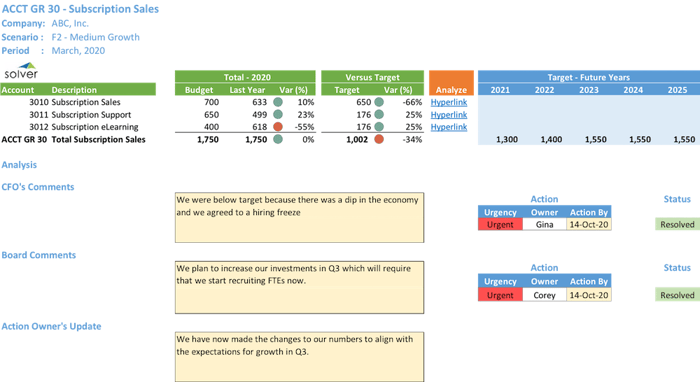
When you plan scenarios and challenge the numbers, make sure you keep a careful record of what you decided.
As you will see, using the tools included in Corporate Performance Management solutions like Solver will make challenging the numbers easier:
- CFO Review process
- Budget Accuracy assessment
- Budget KPI Report
- Variance to targets
- Use of comments to document
9. Invite Executive and Board Feedback Early On
These budgeting process best practices should help your finance team and the entire company create a better budget, more quickly and accurately than you would if you were using the “broken” processes and methods we mentioned earlier – but remember that creating the Annual Budget is only one part of your total task.
In times of economic uncertainty, it can be nerve-racking to present your finished budget to the Board and Executive team and elicit feedback from them. By following the best practices outlined throughout this document, you can improve your process, your outcomes, and your confidence levels… and with these final tips, you can also improve the success of your Board approval process.
Here are three tips that can help you better ensure that your Annual Budget will be approved:
- Be prepared with all of the numbers, as well as the “how” and the “why” behind those numbers.
- Include the Executive team and Board members early on in the process, using active communication to minimize noise at the approval stage.
- Accept Board and Executive challenges to revenue or expenses if you know that the “how” of achieving them can be developed once the budget is approved.
A Corporate Performance Management solution, such as Solver, can help you ease the Executive and Board feedback and approval process using a unique combination of software features and capabilities, including:
- Executive comments
- Department feedback
- Status tracking
Get Started Today with a Sample Budget Process Flow Calendar
Ready to get started now? Smart choice.
Here is a sample budget calendar that you can use to begin setting up your streamlined process. Feel free to model your own calendar after this one. Make sure to include all applicable stakeholders and realistic deadlines to encourage full accountability.
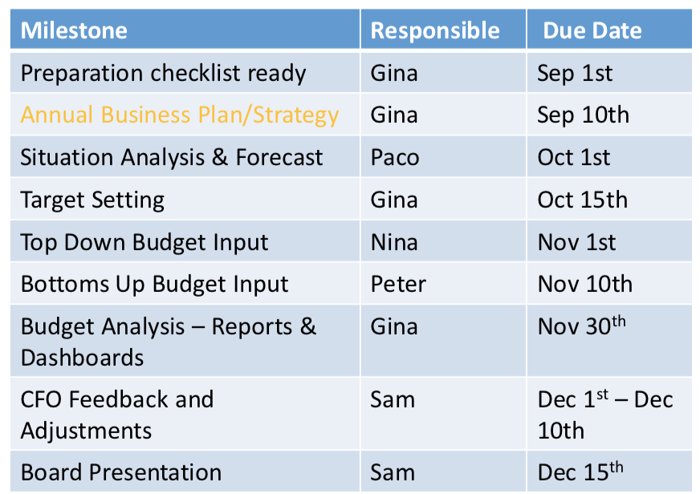
Using the Solver Process Manager, Budget Managers can easily and quickly create reasonable budget calendars that hold staff accountable to deadlines.
Now Is the Time to Start Your Annual Budget Process
As they say, there is no time like the present. When it comes to crafting your Annual Budget in times of economic uncertainty, this advice is more important than ever before.
To ensure the most successful outcomes for your Annual Budget process, follow these summarized steps, in order:
- Start preparing now
- Execute your Annual Budget planning like any other internal project
- Challenge all assumptions, so you can align goals and expectations
- Communicate with all stakeholders at every step
- Ask questions early
And, of course, make sure that you ask for help when you need it so you can stay on track when you run up against unexpected obstacles.
For that last one, and for every step along the way, the budget planning experts at Solver have got you covered. With Solver, you will have access to hundreds of financial planning templates and reports, plus our extensive template glossary and experienced staff who are always happy to share their expertise.
If you have questions about how you can streamline and improve your Annual Budget process flow with budgeting process best practices, our support experts are ready to help you get the most out of Solver’s flexible and robust financial planning tools. Solver is committed to helping you set up your Annual Budgeting process for success, so you can maintain more certainty about your business’s financial future.
Start Reducing Uncertainty and Fixing Your Budget
Contact UsClick here to add your own text
TAGS: Budgeting
Global Headquarters
Solver, Inc.
Phone: +1 (310) 691-5300

